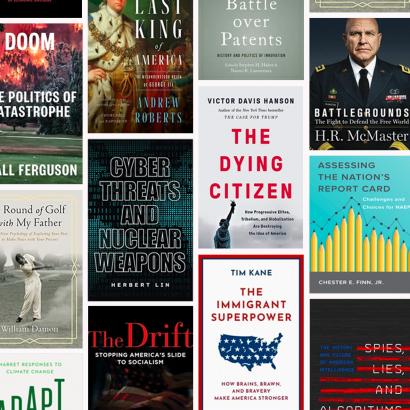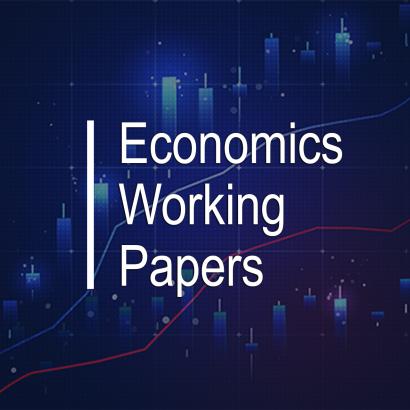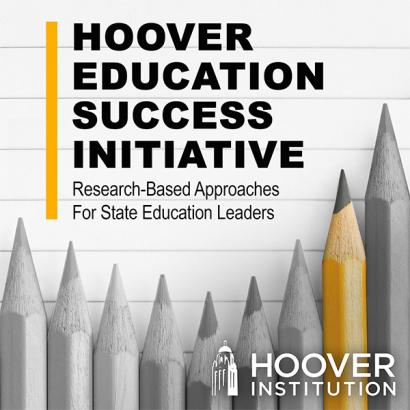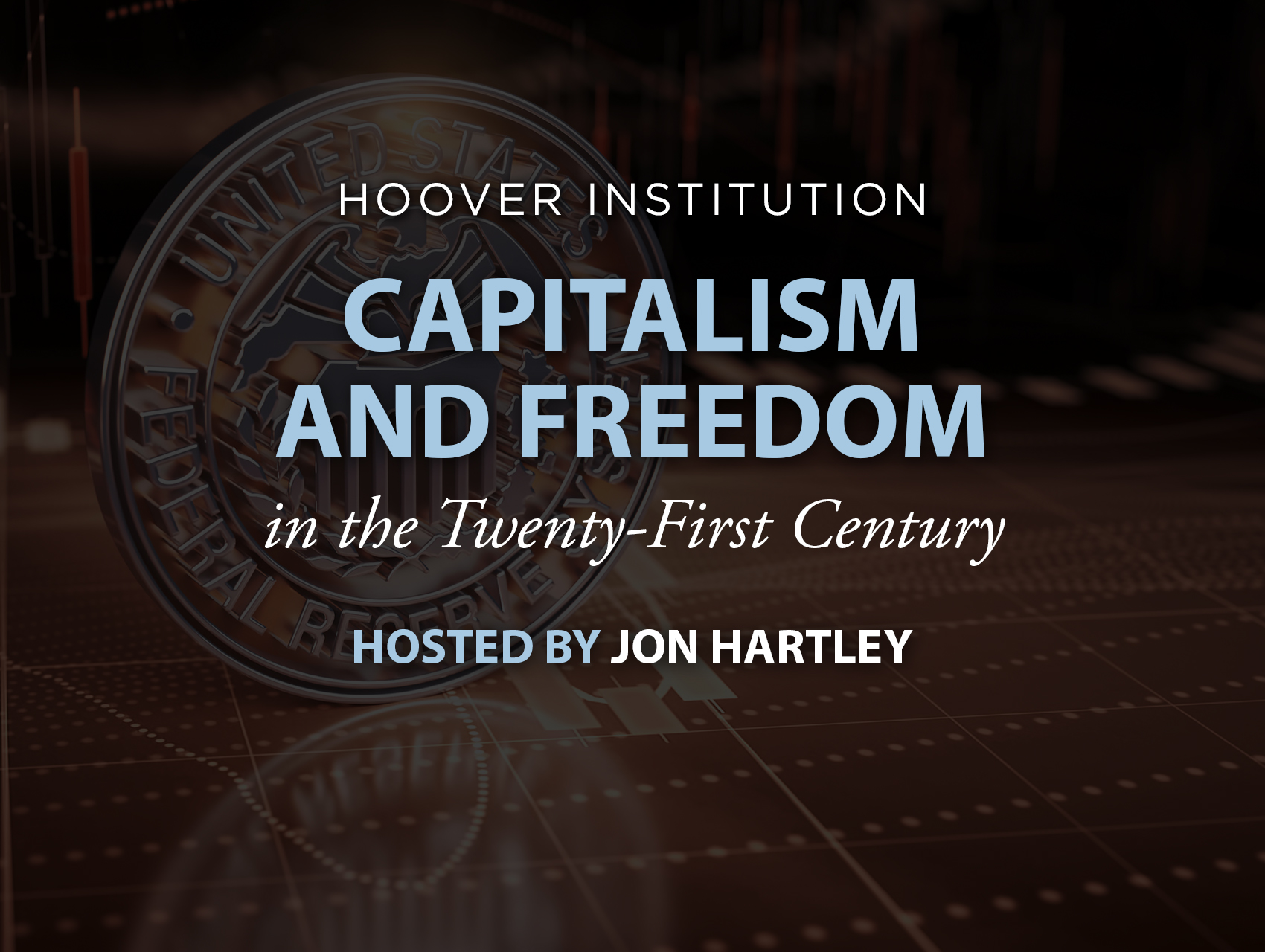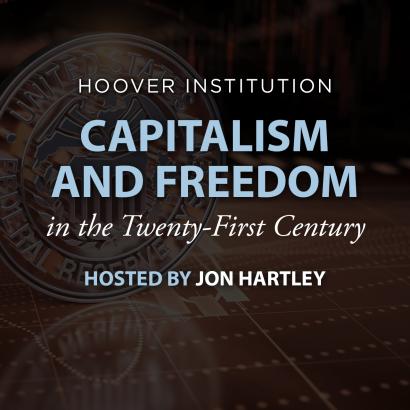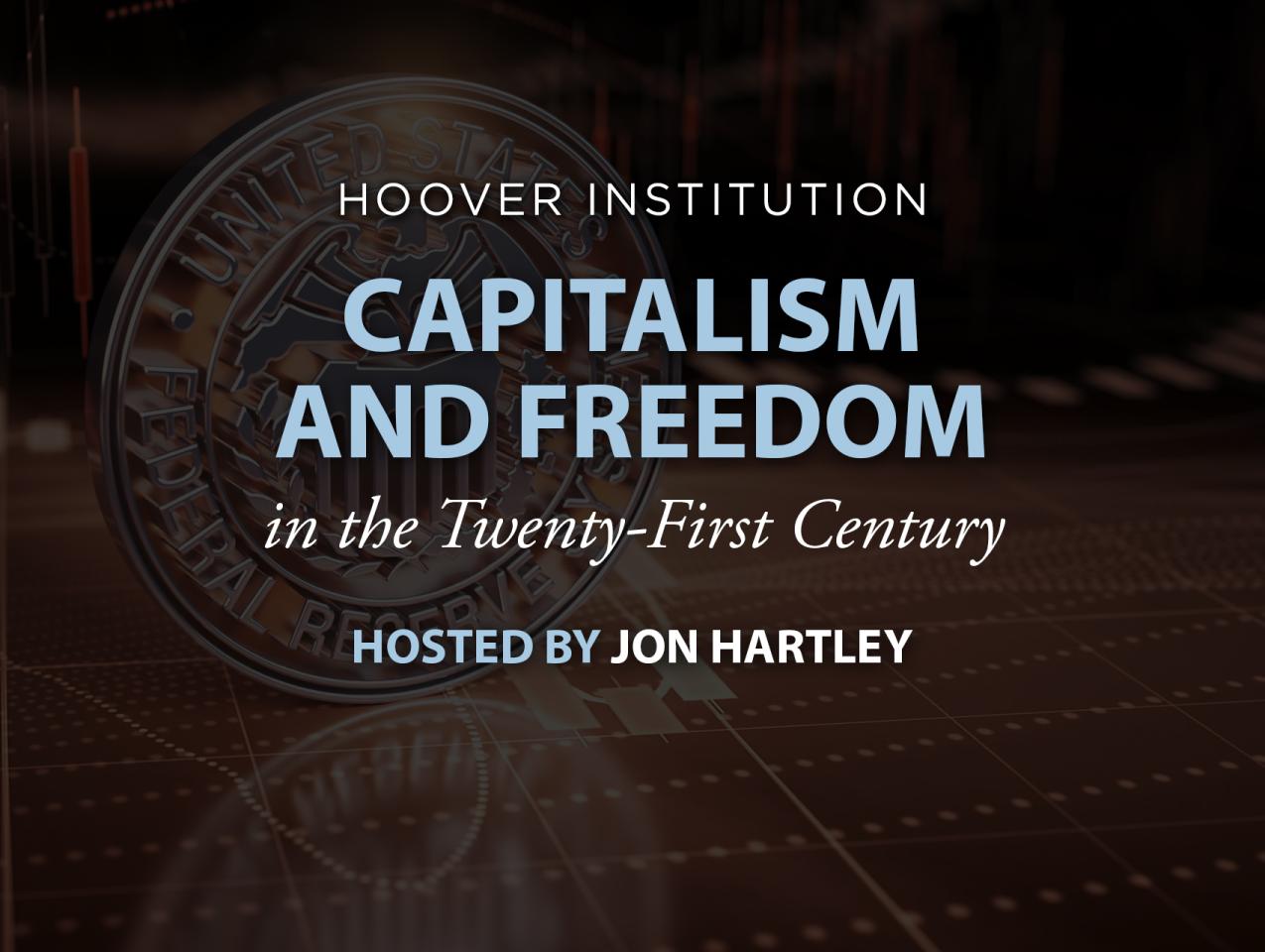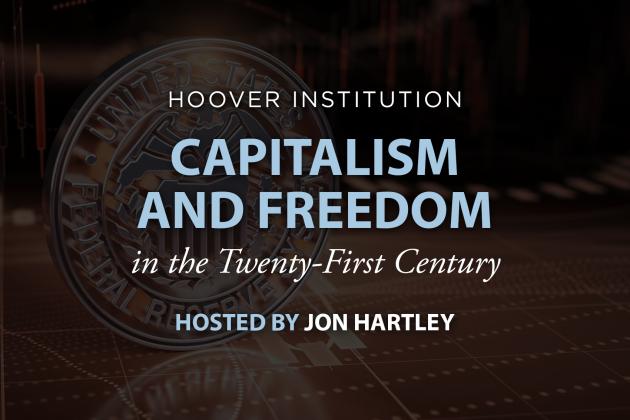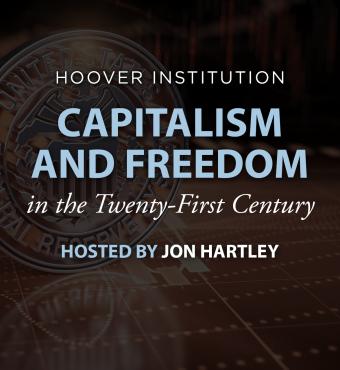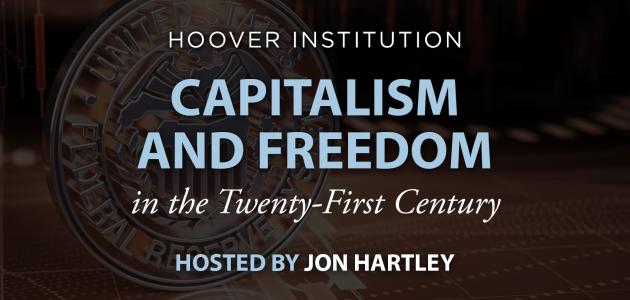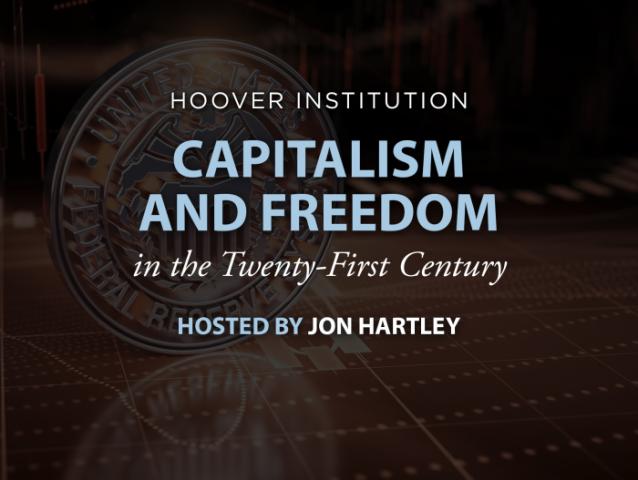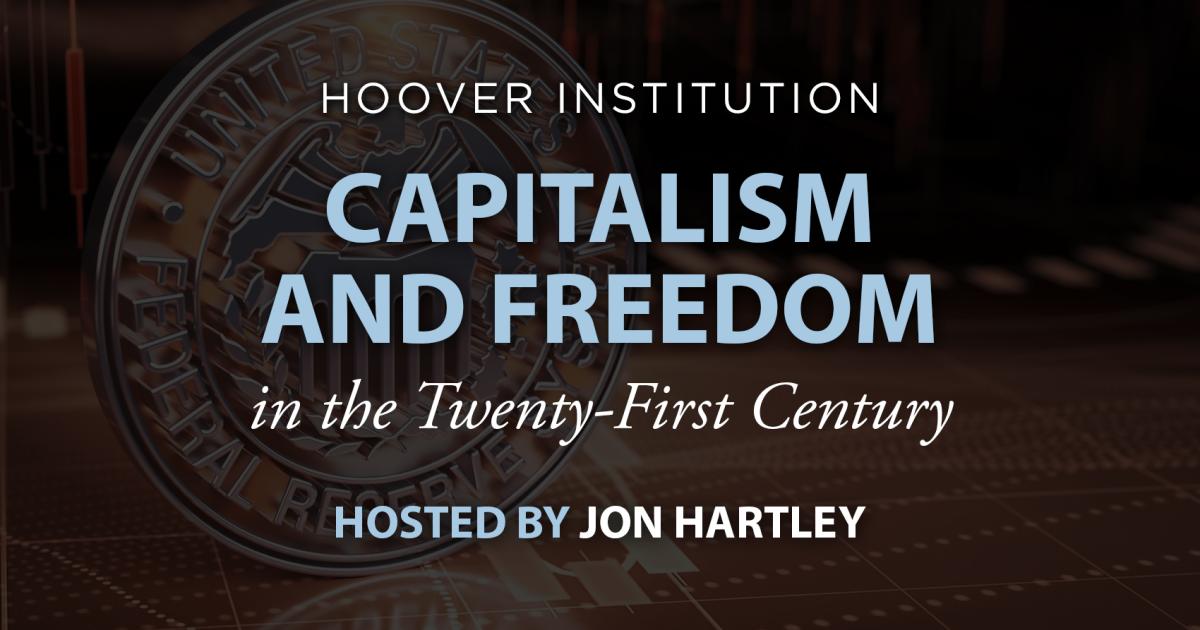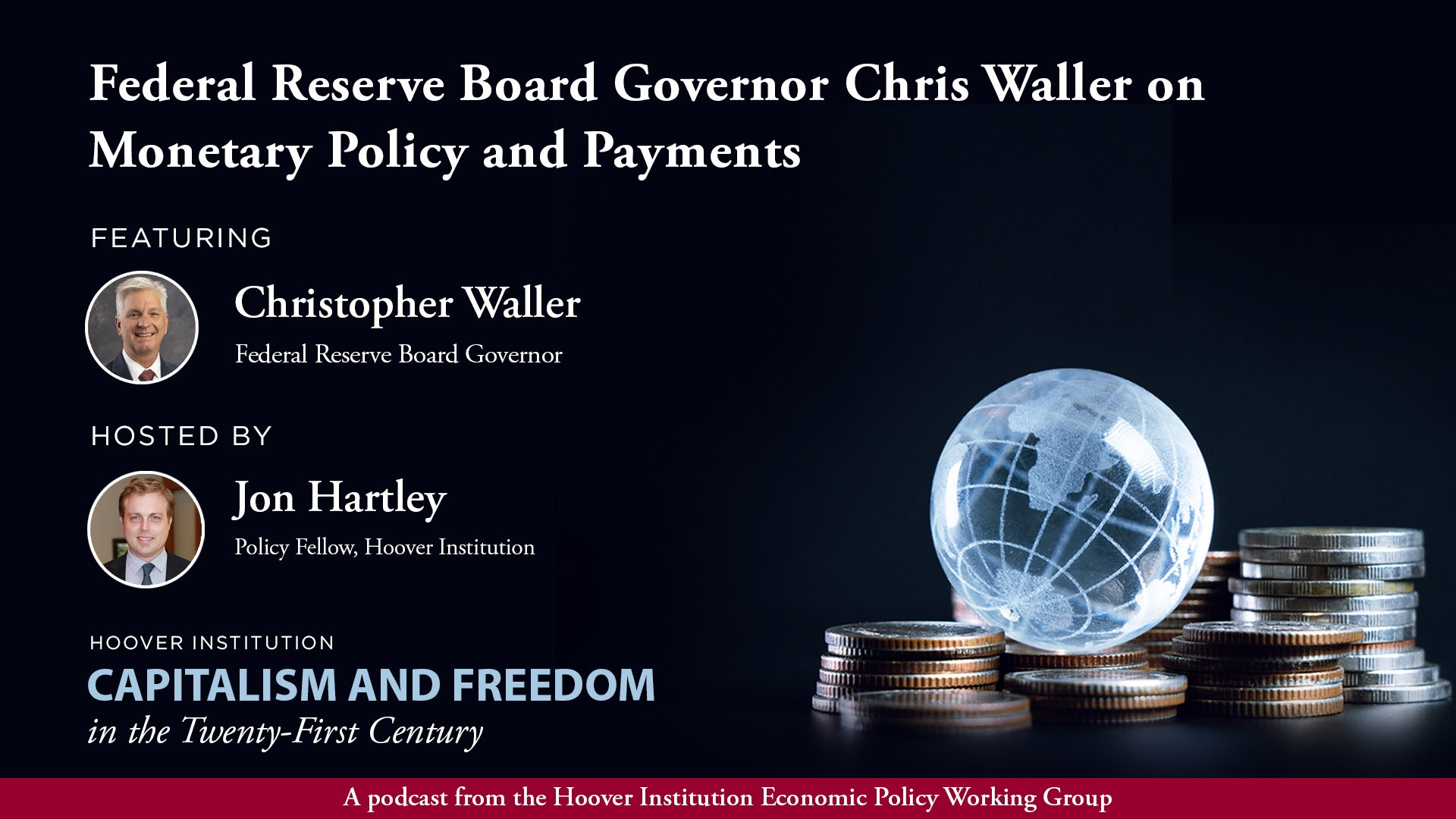- Economics
- Answering Challenges to Advanced Economies
Jon Hartley and Chris Waller discuss monetary policy at the Fed, r-star, and the stance of monetary policy, the 2025 Federal Reserve framework review, quantitative easing and the size of the Fed balance sheet, the early 2020s inflation, and how payments are evolving since the passage of the GENIUS Act.
Recorded on August 28, 2025.
>> Jon Hartley: This is a live recording of an episode of the Capitalism and freedom of the 21st Century podcast, an official podcast of the Hoover Institution Economic Policy Working Group where I, Jon Harley, I'm your host. I'm also a policy fellow at the, at the Hoover Institution. It's so great to have Federal Reserve Board of Governor Chris Waller here as my guest for this live episode at the Economic Club of Miami, which is also being live streamed on Bloomberg Box Business and C Span.
Chris, thanks so much for coming to Miami and for coming on the show.
>> Chris Waller: Thanks. This is my first podcast. I'm looking forward to it.
>> Jon Hartley: All right, well, first question.
>> Chris Waller: And then.
>> Jon Hartley: Let's get started and maybe address, I guess the, what some may say is the elephant in the room.
Some of your colleagues at the Federal Reserve Board are on the news. For those who haven't been following the news, any comments on the status of this situation? I think there might have been a lawsuit dropped today or something like that.
>> Chris Waller: Yeah, when it comes to this, I, I really don't have any comment.
Things now are in the hands of lawyers in the courts. Not, not a poor, simple policymaker like me.
>> Jon Hartley: Okay. All right. Well, moving on to our first economic question really about the federal funds rate and where it's going to. I mean, you gave us a great economic outlook in your speech.
CPI inflation now is both headline and cores are about 2.7% year over year. It's been below 3% for quite a while. Unemployment's been around 4.2% for a while. And there's still another non farm payroll report that still has to come up between now and the next FOMC meeting.
That could change a little bit. But the fed funds rate is currently at 4.25%. You said earlier that you'd like to see maybe a 25 basis point cut at the next meeting. Would you like to see more cuts at further meetings down the road? I'm curious, what's your position on the trajectory of the fed funds rate?
>> Chris Waller: Yeah, that's what I said at the end of the speech was I fully expect more rates cuts as the labor market continues to soften. Growth is probably still going to be slow in the second half of the year. And the tariff effects, any tariff path through effects will probably peak by the end of this year, beginning in 26.
So because monetary policy tends to work with these kind of long lags, you don't want to wait and then you're behind the curve. So my view is we should start getting ready, look through whatever price effects are happening right now. I don't believe they're going to be persistent.
I know I'm a bit of an outlier in the FOMC because of that. But this is exactly what economic theory would tell you. Look through the tariffs. Inflation will flatten out once the tariff effects are passed through and then we can continue moving on cutting to protect the, the real side of the economy.
But the pace and the speed. I like to give this example. I went to college in northern Minnesota. When I would drive home for Christmas, I knew exactly where I was going. But how fast I got to Minneapolis, depending on the weather and the weather's like your current data in determines whether you can go fast, whether you gotta go slow, how much you can.
So that's the kind of way I think about the rate cuts. We know roughly where we're going towards neutral, but how fast we get there is going to depend on the data that comes in.
>> Jon Hartley: So you prefer a pace of sort of success, of potentially success of 25 basis point cuts, not a bigger 50 basis point cut or more at the beginning.
>> Chris Waller: Yeah. And it's not a set sequence, it's not 25, 25. That's what I mean by the data. The data will kind of determine how fast we go. It could be a sequence of cuts, it may be a couple, then you may want to pause if the data is coming in in an odd way.
So that's, that's what I mean. How fast you know where you're going, that's the key thing we know we want to head towards neutral. It's just a question of how fast we get there.
>> Jon Hartley: So I'm, I'm a nerdy economist like yourself. I want to ask you, I want to ask you about R Star.
>> Chris Waller: Does anybody know what R STAR is? No.
>> Jon Hartley: See, for those who don't know R Star, it's really the level of the interest rate where inflation's either accelerating or decelerating. So it kind of tells you where are we at in terms of whether monetary policy is tight or accommodated.
And so the fed funds rate's currently at 4.25%. So if you thought that the R was much lower, then you'd say it's a very tight stance of monetary policy right now. If you thought, well R STAR was at about 4.25%, you would think that we're at neutral. So I'm curious.
One, there's a lot of different ways in which people assess R star. There's model driven estimates, there's a Luback Williams estimate that's about 2.75. There's the UBIG Matthews nominal R star, that's around 3.75. These are nominal numbers. I'm personally a fan of the survey based R STAR estimates.
The New York Fed has this survey, it's called a survey for market expectations. They ask Wall street types or hedge fund or primary dealers, market participants, what the Fed likes to call them and ask them what their estimates of R STAR is. And you can take the median of that and that's about 3.25 right now.
And that median pretty closely follows the FOMC median R estimates that are put in the summary of economic projections. We don't get to see or know who the dots are. And these, the famous dot plots, Chris is one of them. But I'm just curious, sort of big picture one, where do you think R STAR is?
How do you think about R star? You're a monetary economist. How do you think about formulating that in your own mind and sort of creating your own dot? I mean, do you follow survey based estimates? Do you follow model based estimates? Do you follow market based estimates, say long run interest rates and so forth?
How do you think about it as a monetary economist?
>> Chris Waller: Well, so just the way I think about our STAR is if the FOMC or the Fed, if we were hitting our inflation target at 2% and we were at maximum employment, where you're, that's your goals for the dual mandate and you're hitting them and you're sticking there and inflation expectations are anchored, what should the interest rate be?
That's what we call our star. It's like what would it be if you were right on target and everybody's expectations were anchored? The interest rate is composed of two parts. Some expected inflation which should be hopefully 2% if you're on target, and some real rate of return. And the real rate of return used to be thought of as 2%.
So if you had a 2% target for inflation and a 2% real return, the nominal rate at neutral would be 4%. That was kind of standard wisdom for a long time in central banking. What we noticed about 10 years ago was it's real, this real rate. Even though inflation was anchored pretty much around 2%, the real return on safe liquid government debt was falling from about four to two to close to zero about 10 years ago.
So there was something going on that people were willing to pay more and more, a higher and higher price for safe liquid US government debt, which meant that the yield that they got was going down. So this is where this whole debate about Russia, it was falling, falling, falling.
It's been very low. And now the debate is, is it going back up? Is it going to stay low? I know this is totally geeky. If I were sitting in the audience, I'd be shooting myself. But this is a serious problem for a policymaker and nerds like Jon.
So that's kind of where we're at. When I was saying 3% was a median estimate, that's what I mean. Right now we think if he had a 2% inflate inflation target, the median FOMC member would think that the real interest, once you net out inflation effects, would be about 1%.
Which is significantly lower than 2% and certainly lower than about 4% early in the, in the mid-80s. The question is, is it going to continue? Is it going to start rising? And it was close to zero, it's up to about one, is it gonna keep going or is it gonna stay there?
And that's where a lot of energy research discussion has tried to figure out where do we think this is? And as Jon said, these numbers are kind of all over the map. If you even look at the FOMC survey of economic projections, they run from about two and a half to close to 4%.
So even on our committee that's how big of the range is and how much uncertainty there is. So that's basically the way I kind of look at it is it's going to be a point estimate that moves around over time. And I gave a speech back in May of 24 at the Central bank of Iceland where I gave a whole speech on what does it mean about R Star, why has it been falling, what did I think caused it and what do I think could cause it to go back up?
So if you're really bored some night, go find that speech and give it a read.
>> Jon Hartley: That's very enlightening. As a nerd, as a nerd, very enlightening for me, selfishly. I do wanna talk a little bit about inflation, but inflation during the COVID pandemic and I think a lot of people here probably remember this and I'm sure some people may still be upset about it, we did get cumulative inflation or a price level increase of 20% that's permanent we haven't reversed any of that.
I'm curious, what did teen transitory those at the Fed who thought that sort of inflation would come back down without Fed fed funds rate hikes at the time, what did they get wrong? And I'm curious, should the Fed have started raising interest rates earlier than March of 2022?
I'm curious what your theory of the early 2000s inflation is. You know, was it supply induced inflation, demand induced inflation by say, you know, stimulus and so forth, supply induced by, you know, supply chains and so forth? Or was it a supply and demand induced inflation in your mind?
>> Chris Waller: Yeah, it clearly was both, I mean the whole Covid panic was a problem because it kinda hit the whole world. And then when everybody's working at home or sitting at home, you can't really produce stuff. So whatever's being available out there, the prices start being dead up because everybody's Sitting at home with nothing to buy the goods.
So some of it was just the supply chains were restricted, we were all still buying. There was a lot of stimulus from the federal government and the Fed as well to try to support because we really thought this would turn out to be something like the great financial crisis where we have to step in and do a lock.
So you had both the supply side from supply chains, demand from supportive policy. And then the economy just recovered faster than I think we thought. So I was on throw all the knives you want, but I was on team transitory in 2021 because I gave a speech in May of 21, I said, look, what are all the reasons people think inflation's going to go up?
And I walked through every single one of them and said, these are just price level effects. They don't just cause prices to continue to go up and up and up and up and up. My economic reasoning just said it can't happen. So that was, I think, a general belief that we had.
What happened is those price level effects turned out to be much bigger and much more persistent than, I know certainly I can't speak about any of my colleagues, but for me it was a surprise at how big and persistent these changes were. And I gave a speech in Korea back at the end of first week of June where I kinda laid out what caused this persistence, what was it that caused all these things?
So I don't want to go through a big hullable about it, but those things which was like the COVID it wasn't just one wave of COVID it was wave after wave after wave. And they weren't synchronized around the world. So we would start reopening and somebody else would shut down.
And every time somebody shut down, they broke the supply chains and we still had a lot of stimulus money pouring in. Fiscal policy was very accommodative, monetary policy was accommodated for too long. And that also just led to more persistence in inflation. Now why is this important? Because from that experience we should have all learned our lesson that you don't say the word transitory.
And what am I doing? I am saying whatever tariff inflation you get will be transitory. That was a pretty bold thing to say about eight months ago because everybody immediately said, you're an idiot. But I think we're now starting to see that tariffs are a very different thing.
It's not clear how much is going to get passed through. It's one thing causing it, it's not multiple broken chains, fiscal policy monitor. So it's to me very clear there's really one thing we gotta worry about, those prices if there's any pass through, there'll be some. Once they pass through, it's over and it won't continue to cause prices to go like that.
So based on that long standing central bank wisdom is you just look through it. Just like if you increase the sales tax in every state, that would raise the price what everybody has to pay. But no one would say that's going to just cause inflation go taking off.
And I doubt very much that workers would go to their bosses and say, hey, the city just raised my sales tax, I need a raise. I don't think your boss pay any attention to you. But it's weird with tariffs, that's immediately what people start saying, tariffs, prices will go up and it'll be more expensive.
Like I asked for a raise. Well, you don't do it on the sales tax. You don't do it if your income tax goes up or any other taxes go up. What is it special about tariffs in which you wanna act differently? So that's kind of where I'm at.
I'm back on team transitory. We'll see how it all works out. Some of my colleagues have some bets against me, but I'm sticking to it. That's my line.
>> Jon Hartley: Very good. Well, I want to talk a little bit about Jackson Hole, where you were last weekend in Wyoming.
And there was a lot of discussion about Chair Powell's speech, in particular on that framework review. So he, I think suggested last week that the Fed from a framework review standpoint was potentially returning to the sort of 2012 Bernanke symmetric 2% inflation target and kind of abandoning the so called flexible average inflation turn your fate regime.
That was adopted in the last framework review, that was in 2020 and sort of a brainchild of Rich Clarita. Any thoughts on the 2025 framework review? What do you think it should go? Where do you think the Fed should go from a framework review perspective in your mind?
>> Chris Waller: So for those of you again who are central bank geeks, a framework, we have a goal. Our goal is 2% inflation, price stability, which is how we define it, and maximum employment. Those are great goals. How are you going to get there? What's your strategy? How are you going to act when the data isn't getting you there?
So that's when, when Jon says our framework, that's what people, that's how we interpret the framework. It's our strategy for how we're going to respond to the data to get us to these goals. That's kind of the simplest way to explain what the framework is. Now, in our last framework, we had spent 10 years with inflation running well below our 2% target.
And you'd say, what's wrong with that? Okay, maybe there's nothing wrong with it, but inflation expectations started drifting down away from. From 2%. And so what that implied is our promise of 2% is not, is losing credibility, whether you like it at 2 or 1 or 0. But if you pick 2 and its expectations are drifting down, you're losing credibility.
So there's a lot of things that happened in the 2010s. We were at zero, lower bound. The economy was recovering from the financial crisis. The massive amounts of regulation went in after the financial, particularly in the financial sector, and all these things do nothing but slow down growth and put downward pressure on demand and prices.
So we took the 2020 approach, was like, we gotta get inflation and get closer to two. So the expectations come back up, our policies are more credible. And so one thing that people thought was when you say 2%, is it a ceiling where you're happy if it's 2 or less or you really mean it's 2?
So if it's been low, you let it run above. So on average you get to two. And that's what Jon was saying, that was called flexible average inflation targeting. Meaning if we had been running below target for a while, we were willing to let it run above target to get it back to two.
That's as simple as I can explain it. The problem is as soon as we adopted this policy of saying we're gonna let inflation run above target, guess what happened? It went all above target, all by itself. We didn't have to do anything. So the whole framework kind of got blown out of the water right away.
And so given that we've been above our inflation target for about five years now, it's like, why are we saying we'll let it run above target? Because it's been running low, it's not been running low. So we had to step back and say, look, that framework was too tied to the 2010s.
It was, to my view, I'm speaking for myself, it was too backward looking, it was too specific, it was too cute in a way of how we were going to manage things. Too discretionary, too much fine tuning. And I think we've realized, look, we want to go back, talk about our strategy, but do it in a more robust, less detail, less complicated way in terms of how we approach that is.
And that's in the end, that's kind of what the new framework does. It kind of goes back to where we were roughly in 2012. And we're trying to make sure that whatever happens going forward, this is a robust framework.
>> Jon Hartley: Yeah, I think that sort of reflects, I think, a broad kind of consensus amongst economists.
That flexible average inflation targeting was maybe a bit of a misadventure. I want to talk more about the balance sheet for a second. So think quantitative easing, quantitative tightening. This is the Federal Reserve going out buying say long term Treasuries and mortgage bonds and so forth that they started doing largely after the gold financial crisis in 2008.
The Fed balance sheet's now at about $6.7 trillion. It was at 9 trillion in 2022. How does the balance sheet factor into your thinking? And is a big balance sheet something that you think we're going to have maybe forever? Do you think we could ever get back to reserve neutrality?
And where do you think the balance sheet is going in the future?
>> Chris Waller: Yeah, so I just gave a speech on the balance sheet about six weeks ago trying to explain what our balance sheet is, what are our structure of it, how should we, how should we structure balance sheet?
And I made the joke that most people would rather go to the dentist and talk about the Fed's balance sheet. I see people starting to walk out already. So your audience. But the punchline is we have three major, I'll do this all in like a ChatGPT version of the speech.
We have three major liabilities on our balance sheet. We have currency which is about 2.3 trillion. The Treasury's checking account is on our balance sheet. We're in the bank for the U.S. treasury. That's about, normally it's about $800 billion. So you're up to about 3.1 trillion. And then we have a policy that we want to make sure banks have enough liquidity and reserves that we never have a panic where everybody's chasing looking for loose coins in the cushions.
The banks always have the liquidity that they need. What the right amount of liquidity that the banks need is an open question. And right now we're kind of staring at this and let's say it's somewhere between 2.7 and $3 trillion to make sure the entire banking system has the liquidity that they need so we never have to worry about running around chasing currency.
That means your balance sheet is close to about 6.2 trillion, 6.0, anywhere from 5, whatever, to of that. That's a large number. It just sounds like a big balance sheet but. And it's certainly bigger than what we ever had pre global financial crisis. But the point is, even if we got rid of all the reserves, we went back to a scarce reserve, what we call the scarce reserve system.
When you had maybe only 25 billion instead of $3 trillion of reserves, our balance sheet would still be well over $3 trillion just from currency in a treasury checking account. So about half of our balance sheet side is out of our control. Really. Currency we print on demand.
And there's a good reason for that. We never want anybody to doubt when they go to their bank and they want to say, I want a dollar bill that the bank says, I don't know if I can give it to you because I don't know if the Fed will give it to me.
The answer is we will always give you that dollar bill. Don't worry about it. Make sure your customers know they will never have a problem getting currency if they want it. So there's a good reason. We supply it on demand. And the Treasury's checking account, you know, that's gotta talk to Scott Best, that's his decision of how big they want to carry a balance.
And just over time that thing has gone for maybe 25 billion 20 years ago, up to like 800. Part of it is just the fact that we have much bigger government spending and bills have to be paid in a larger amount. And that requires and generally have a bigger balance in your checking account.
So in a nutshell, there you go. That's the balance sheet. Enjoy. I hope you sleep well, Tom.
>> Jon Hartley: All right, very good. Tremaine will be sleeping safely at home knowing that we'll have a big balance sheet for quite some time at least. So, debt and deficits. I want to talk a little bit about this because it's something that gets talked about a lot.
So one, I think the debt to GDP ratio in the US has now passed 100%. There's often criticism of continued deficits is more of a fiscal policy question than a monetary policy one. But in my mind, despite all the haranguing about debt and deficits, the 10 year yields maybe 4.2%, the 30 year yields about 4.9%.
They've been much higher in decades past. Do you think the federal debt is something that the American people should be concerned about? What do you think about?
>> Chris Waller: Yeah, so I mean, typically the thing is, is with deficits, we're running about in the last few years and it looks like this year as well, we're going to be running deficits of about 6 to 7% of GDP.
Typically that number should be closer to 3 to be what we would say as economists, as economists, what would be sustainable going forward. So if you're running 6% deficits as part of your total national income. When I say gdp, it's our national income as a group. You're incurring a lot of debt given what your income is.
That's what the debt to GDP ratio means. Now, the thing with the debt is it's gonna be potentially paid off hundreds of years into the future. We can pay it off as a country. End of the life of the country in some sense. So you can spread out the repayment of that debt over decades, it doesn't have to be all at once.
But you can't just continue to run these kind of deficits for 100 years, 200 years. It just doesn't quite work out. So while it's not of Problem per se. Today it's not on a sustainable path. And at some point they don't have to be reigned in. I don't tell Congress how to either rein it in by cutting spending or raising tax.
That's not my job. And I don't, that's, I leave them to do that so they don't bother me on interest rates. But I mean that's just, this is just kind of arithmetic. If you don't get the spending deficit down, your debt's going to grow, grow, grow, grow as part of your income.
And at some point markets are going to stare at it and say, look, I'm not financing that anymore, I'm going to, or I'll finance it, but at a very high interest rate. And that's what we've seen around the world when some countries get to very high debt limits.
The exception always being Japan. Japan has a 250% debt to GDP ratio and they have interest rates close to zero. So obviously something either people believe Japan will pay this off over a thousand years. They've been around for a couple thousand years. Maybe that's their long civilizations are more tolerant of what they're willing to incur.
So that's just been a position I've taken. We're not on a sustainable path. It doesn't mean we're in any kind of trouble now. But at some point we're gonna have to get some sort of fiscal discipline and I don't like Congress figure out how to do that.
>> Jon Hartley: One question, also non-monetary policy related question, really just on payments and I guess finish regulation.
So for those that aren't aware, on top of managing monetary policy, the Federal Reserve also focuses on regulating banks, also managing the payment system. Chris spends a lot of time in his own capacity managing sort of the payments part of the portfolio. I'm curious, can you tell us what's been going on in the payments space during your tenure and how things, how things have been changing?
The Genius act was just passed. That changed a lot for stablecoins and that space. But there's a lot going on in this space. Could you explain to the layman here what's going on behind the scenes and what you've been working on in the Fed?
>> Chris Waller: Yeah, if you thought the balance sheet was boring, wait till you start talking about payments.
So I'm the payments oversight governor. I oversee the U.S. payment system. And 25 years ago if you'd said payments and who's doing payments, you'd think of some guy in a green visor and a pad and a pencil. But it's actually become one of the hottest tech jobs in the world because all of this stuff is moving into more technology and it's being handled by non banks, fintechs, everything.
Stablecoins is a new form of a payment instrument that's come about from the crypto world. Just cuz I said crypto, don't get scared, it's just a stablecoin, which is a promise. You give me a dollar, I'll give you this digital dollar, and if you bring it back, I'll give you your dollar back.
It's really no different than a bank account at that point. I give a bank a dollar, I come back and ask for my dollar, they give me the dollar back. But what it does is it opens up a new set of payment rails in the US through the crypto world.
They don't run on Visa, MasterCard, they don't run on the bank rails, they don't run on the Fed Rails. And that just, for me, that just introduces competition in the payments world. And what that means is this should drive down payment costs for all of us so that we can make payments across each other, cross borders, cross everything at a much lower cost.
And my view is let everybody that wants to get in this business do it as long as they follow whatever regulatory structure we put in the Genius Act, Banks should be allowed, non banks should be allowed, but it all has to fit within the clear regime that we set up.
The Genius act is a great start, but it's never going to be perfect. Right out of the gate. We're going to learn there's going to be some issues, some problems, but we'll fix them as we go. And that's, that's the critical thing. We're not going to just shut everything down because we're afraid somebody might lose a dollar or somebody might get scammed, somebody might lose money in their assets.
You just have to take risk. And that's, that's what we're going to do. That's how economy grows and gets better as you take risk. If you don't want to take risk, you can become Europe. So sorry, my European friends.
>> Jon Hartley: Well, I know Miami, I think in many respects thinks of itself as the capital of, of crypto.
So I'm sure there's many in the crypto world who, who are very thrilled that you're here and talking about payments and, and stablecoin issues. My last question for you is, is related to college football this week. College football. Man, I'm getting.
>> Chris Waller: Is starting again this week.
>> Jon Hartley: And it just so happens to be the case that Notre Dame is playing Miami University of Miami Hurricanes this week, actually here in Miami this weekend.
I know, Chris. I know you're a big Notre Dame fan, as am I, actually. Any thoughts on this weekend's game? I mean, how many points do you think Notre Dame for him by? And keep in mind here, you've got many Miami Hurricane fans probably in the crowd here, but any thoughts here?
>> Chris Waller: All I ever say when I'm in enemy territory, I just hope for a good game.
>> Jon Hartley: Very good. Very good. Well, Chris, I wanna thank you for coming to the Economic Club Miami and for appearing in the special live taping of the Capitalism Freedom of the 21st Century podcast.
I hope that Notre Dame does better than they did in the the finals last year and in 2012 when they played Alabama actually here for the the championship then as well, which I think you were actually at.
>> Chris Waller: I was at.
>> Jon Hartley: It's painful memories, but hopefully this weekend it'll be a good game.
But Chris, thank you so much for coming. This has been an amazing conversation. Thank you everyone for coming.
ABOUT THE SPEAKERS:
Christopher J. Waller took office as a member of the Board of Governors of the Federal Reserve System on December 18, 2020, to fill an unexpired term ending January 31, 2030.
Prior to his appointment to the Board, Dr. Waller served as executive vice president and director of research at the Federal Reserve Bank of St. Louis since 2009.
In addition to his experience in the Federal Reserve System, Dr. Waller served as a professor and the Gilbert F. Schaefer Chair of Economics at the University of Notre Dame. He was also a research fellow with Notre Dame's Kellogg Institute for International Studies. From 1998 to 2003, Dr. Waller was a professor and the Carol Martin Gatton Chair of Macroeconomics and Monetary Economics at the University of Kentucky. During that time, he was also a research fellow at the Center for European Integration Studies at the University of Bonn. From 1992 to 1994, he served as the director of graduate studies at Indiana University's Department of Economics, where he also served as an associate professor and an assistant professor.
Dr. Waller received a BS in economics from Bemidji State University and an MA and PhD from Washington State University.
Jon Hartley is currently a Policy Fellow at the Hoover Institution, an economics PhD Candidate at Stanford University, a Research Fellow at the UT-Austin Civitas Institute, a Senior Fellow at the Foundation for Research on Equal Opportunity (FREOPP), a Senior Fellow at the Macdonald-Laurier Institute, and an Affiliated Scholar at the Mercatus Center. Jon also is the host of the Capitalism and Freedom in the 21st Century Podcast, an official podcast of the Hoover Institution, a member of the Canadian Group of Economists, and the chair of the Economic Club of Miami.
Jon has previously worked at Goldman Sachs Asset Management as a Fixed Income Portfolio Construction and Risk Management Associate and as a Quantitative Investment Strategies Client Portfolio Management Senior Analyst and in various policy/governmental roles at the World Bank, IMF, Committee on Capital Markets Regulation, U.S. Congress Joint Economic Committee, the Federal Reserve Bank of New York, the Federal Reserve Bank of Chicago, and the Bank of Canada.
Jon has also been a regular economics contributor for National Review Online, Forbes and The Huffington Post and has contributed to The Wall Street Journal, The New York Times, USA Today, Globe and Mail, National Post, and Toronto Star among other outlets. Jon has also appeared on CNBC, Fox Business, Fox News, Bloomberg, and NBC and was named to the 2017 Forbes 30 Under 30 Law & Policy list, the 2017 Wharton 40 Under 40 list and was previously a World Economic Forum Global Shaper.
ABOUT THE SERIES:
Each episode of Capitalism and Freedom in the 21st Century, a video podcast series and the official podcast of the Hoover Economic Policy Working Group, focuses on getting into the weeds of economics, finance, and public policy on important current topics through one-on-one interviews. Host Jon Hartley asks guests about their main ideas and contributions to academic research and policy. The podcast is titled after Milton Friedman‘s famous 1962 bestselling book Capitalism and Freedom, which after 60 years, remains prescient from its focus on various topics which are now at the forefront of economic debates, such as monetary policy and inflation, fiscal policy, occupational licensing, education vouchers, income share agreements, the distribution of income, and negative income taxes, among many other topics.
For more information, visit: capitalismandfreedom.substack.com/


